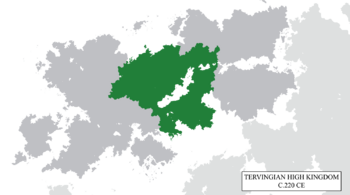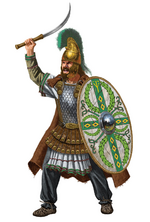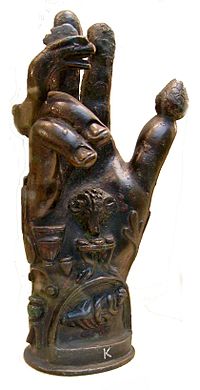Tervingia: Difference between revisions
No edit summary |
No edit summary |
||
| Line 69: | Line 69: | ||
|image_map2_alt = | |image_map2_alt = | ||
|image_map2_caption = | |image_map2_caption = | ||
|capital = [[ | |capital = [[Valegoria|Saragetra]] | ||
|capital_exile = <!-- If status="Exile" --> | |capital_exile = <!-- If status="Exile" --> | ||
|national_motto = | |national_motto = | ||
Latest revision as of 10:36, 11 March 2024
This article is incomplete because it is pending further input from participants, or it is a work-in-progress by one author. Please comment on this article's talk page to share your input, comments and questions. Note: To contribute to this article, you may need to seek help from the author(s) of this page. |
Tervingian High Kingdom
| |||||||||||||||||||
|---|---|---|---|---|---|---|---|---|---|---|---|---|---|---|---|---|---|---|---|
| 323 BCE–429 CE | |||||||||||||||||||
 Largest extent of Tervingia, c. 220 CE | |||||||||||||||||||
| Status | Dissolved | ||||||||||||||||||
| Capital | Saragetra | ||||||||||||||||||
| Religion |
| ||||||||||||||||||
| Demonym(s) | Tervingian, Gothic | ||||||||||||||||||
| Government | Empire | ||||||||||||||||||
| History | |||||||||||||||||||
• Established | 323 BCE | ||||||||||||||||||
• Dissolution | 429 CE | ||||||||||||||||||
| |||||||||||||||||||
Tervingia was a major Gothic political state and cultural power in eastern Belisaria which existed from 323 BCE to its dissolution in 429 CE.
Etymology
History
Origin
The general Lake Kupalnitsa area had long been inhabited by a diverse group of ancient tribes and proto-civilizations, with the north of the lake and the Karmin river delta having been home to proto-Germanic and later Gothic tribes and petty kingdoms united nominally by their paganistic religion and basic structure of their governments. By 400 BCE, the primary focal point of sociocultural and economic power in the region was the northern Gothic petty kingdom and city of Saragetra, today the Ostrozavan city of Valegoria. Under the successive leadership of multiple petty kings, Saragetra's nascent political structures, which were increasingly centralizing, expanded over the northern edge of the Lake and into modern day Drevstran, where they further assimilated the Gothic peoples of the Azdren lowlands, though the more southern people of the Azdrheg highlands resisted attempts of direct subjugation, instead adopting a policy of harrasment and asymmetric attacks that ultimately halted any further expansion by Saragetra.

The semi-legendary figure, Lorelei Saratheoda, was the the first female queen of the petty Kingdom of Saragetra, and is commonly attested in both regional folklore and contemporaneous accounts by figures in the Latin Empire as the first to consider a pact of equality between different tribes in response to aggressive encounters with both organized and disciplined forces of the empire in the West, as well as Nordic raiders on the major waterways of Gothic lands and increasingly bold proto-Ludic raiders, which had been harrassing the northern reaches of Saragetran territory for over a century.
Thus, Queen Lorelei called the First þiudaþing between rulers in the region in 339 BCE, establishing formal diplomatic relations with Valeni, North Germanic, Ludic, and remaining Gothic polities in the region; many of these peoples agreed to pay tribute to the central Saragetran kingdom in exchange for military protection, thus beginning the political structure of decentralized rule that would lead to a stronger Tervingian government later.
As a beginning of eventual greater centralizaiton of the þiudaþing Pact, Lorelei also managed within two years of the event to secure the more entrenched allegiance of Valeni tribes throughout the Balrog river valley though personal marraige of her second son, Alica, to the eldest daughter of a prime Valeni chieftan, in 327 BCE. By popular tradition, the Prince woke the chieftain's daughter from an eternal slumber placed upon her by the trickster god, Duda, and subsequently married her during Yule celebrations.
Early era
As more stories of a "great army of conquerors" began to disseminate into the Lake Kupalnitsa area, centralization of the Pact seemed to have accelerated, culminating in 323 BCE with the second þiudaþing and the declaration of the Waipsmahts Kunjahaidus Tervingiuta, or "Crown and Customs of the Tervingians". This is considered to be one of the first recorded legal documents in the area, the first mention of the name Tervingia, and the first workable constitution of a nation of peoples in Belisarian history.
Gaetic wars
In 319 BC the city of Wosdef near modern Dravask called the Tervingians for help as they were being besieged by Markos, king of the Gaets, who ruled over the Azdrheg Mountains. The Gaets had been long lasting rivals of Saragetra, contesting its control over the Azdr lowlands. After a successful campaign relieving Wosdef from the Gaetic pressure, the Tervingian gained the loyalty of the germanic tribes living in the Medenzag which meant that they could now threaten the Gaets on two fronts. A second war against Markos is testified by Tervingians Runestones, where his brother, king of the "Horrgets" and him plundered the Azdren lowlands before being defeated in battle at Tabroke, one of the first mention of a ranged battle between Gothic tribes.
The fate of Markos is unclear but by 309 BC it was his son, only known as Markosen in Runestones, who was king of the Gaets. Markosen launched a war against his uncle after the latter refused to relinquish his control on the eastern side of the Azdren Corridor. The king of the Horrgets died in battle, or during a raid, and Markosen then campaigned to be elected King of the Horrgets, with the support of the Tervingians. As a vassal of Tervingia, Markosen was known as the Allegaeti Reike, the King of all Gaets.
Weihswig
A well-established political system, pacified borders, and a period of favorable climate led to a population boom within Tervingia. The first consequence was a demographic shift with the apparition of the first specialized permanent settlements within the Empire, generally centered around metallurgy or pottery as their industries. Many settlements on the shores of Lake Kulpanitsa became permanent affairs as trade and fishing became possible. Nonetheless, the demographic growth was a concern for the population who relied on extensive agriculture for their subsistence. The Thiudathing of 311 BC decided to dedicate every child born in this year to the god Tyr within the participating clans and to organize a weihswig, an "Holy Path". This path was sent to colonize the lands eastwards in modern days central Drevstran. Afterward, the 309 and 307 BC generations were also dedicated to Tyr. The first two generations formed together a single Weihswig launched in 291 BC with the Bull as their Totem. The last sprang up two years afterward as reinforcement under the protection of the Godhand. It's during this period that Angrast was founded at a narrowing of the Drev thus its original name of Anguz.
The success of these first attempts at colonisation encouraged the organisation of other waves of military migration eastward thorough the 3rd century BC. Tervingia thus expanded to the Periclean Coast and established colonies across modern day Drevstran and Brumen which were generally named after physical features of their new lands or after their totem. Considered independent clans, they organized themselves as vassals of Tervingia with their own local assemblies but once they grew enough in size, and depending on the political situation back in Saragetra, they were allowed seats and representatives at the original Thiudathing.
Following the 3rd century, this colonisation and migration movement would die down as a mutating society, changing climate, and new external situations made Dedications increasingly complicated to organize and led to diminishing returns. By the current era, the practice had been all but abandoned.
Culture
Kingship
The political structures of Tervingia were essentially inherited from the Kingdom of Saragetra, which had developed an original, for its time, model. The King was an elected position, and he was adviced by a Council of Elders made of important priests and aristocrats from all around the Kingdom. The King's role was originally simply to organize the military strength of the original tribal confederation and was elected for a single season, then a year. With the help of the aristocracy, a proto-administration would develop around the personality of the King, aimed at collecting the funds and ressources necessary for prolonged raiding campaigns and the protection of the Saragetran settlements. Free from the requirement of a strong charismatic leader to hold together the tribes, the original confederation survived for generations and the constituent tribes began to clear up the defensive wild lands that separated them. To avoid conflicts over farmlands and to better organize the colonisation process, the power of the King were expanded and he became a form of "Supreme Judge". It is also during this period that his mandate became lifelong instead of yearly. This process of empowerement of the kingship and its associated institutions would continue thourough Tervingia's existence.
Military
Originally, Tervingia's military was not fundamentally different from other Germanic peoples. The central crucible was the þiudgar Council, a type of levying of troops. The subsequent parties were generally made of thousands of people each, and each led either by the King personaly or by other prominent aristocrats famed for their bravery and wealth. The þiudgar Council was a major cultural as well as political event, and high amount of quality poured into arms surrounding the Crown's wars often led to innovation in mass-production strategies for the time. Tervingian armor of the time, though somewhat delegated among vassals, was visually consistent for battlefield identification and well-rounded in weight and protection. The logistic capacities and organization brought on by these royal institutions also allowed these raiding parties to be self-sufficent from local logistical needs, while other Germanic raiders were often accompanied by their families.
The basic formation, and unit, of the Tervingian military was called a wedge. Each wedge, led by a Chieftain or Jarl of their respective clans, consisted of the levied fighters from the same village or district. As such, given the average size of a Tervingian settlement, it can be estimated that a wedge encompassed around ten combatants. Large settlements, such as Saragetra or Anguzm, often fielded multiple or larger wedges, often in 500 or more united around a single captain, which then coalesced, in specific formations known as Gagrarjis, which were competent fighting units, who, through the use of the falx, competed with Latin encroachment for centuries. A standard raiding party would have consisted of ten wedges. During the early days of Tervingia, it became common practice for the Kings to raise three parties per front they wished to protect or attack. Only rarely would a King fuse multiple parties into Royal Gagrarjis personally as a large army to fight on a battlefield, as the favorite strategy of the Tervingians was assymetrical in nature, based on raids, resource management, and rapid action. In that regard, the superior logistics of the Tervingians was often the determining factor in foreign wars, both against their Germanic counterparts and with invading Latins and Luds.
Agriculture
The Tervingians, like the other Germanic and Gothic peoples, were mainly farmers and sedentary pastors. They practice an extensive agriculture, with long periods of fallows. Despite this, lands left to rest after their exploitations weren't unproductive : they were used to raise cattles, but also to obtain fruits, honey from wild bees, and fire woods. After a period of four or five years, they would perform Slash-and-burn to further enrich the soils.
Barley was the main crop cultivated by the Tervingians. Differnt varieties of wheat, rye, or oat were also cultivated, depending on the local climatic conditions and cultural preferences. Beans and peas were also cultivated on the northern shores of lake Kulpanitsa. As Tervingia grew and its economy strenghtened, the Gothic people also began to practice horticulture and sylviculture. Flax, and Hemp were also cultivated for the creation of textiles. The "Tervingian Hemp" notably became famous for its quality thourough Belisaria.
Bovines was the main cattle raised, but herds also included porcines, ovines, and poultry. Horses and dogs were also raised as companions and war animals. Depending on the region, Tervingians were avid consumers of cheese which was one of their main source of animal proteins. Bread was rare and limited to wealthy free men and aristocrats. Most of the population ate porridge instead.
Crafting and industry
Manufacturing slowly grew from purely local, if not individual, productions, to more developed and complex forms of work organization. It's under the Tervingians that the Goths began to exploit their own mines and produce their own iron and steel instead of relying on imports. With the "Saragetran Peace", some Goths began to specialize themselves in various crafts, including metallurgy, leather working, and pottery. Metallurgy was the first of these industries to gain a recognized status, as its artisans left the traditional villages to settle in their own fortified "workshop towns" located in the mountains or hills near an important deposit of their favored metal. It's the wealth gained from selling their work that allowed these "Crafters clans" to hire excellent architects to design and build the stone constructions of these new cities, a first in Tervingia.
Religion
The deity most favored under Tervingia was Tyr to the point his cult has been refered to by modern historians as a "state cult" for the Empire. It's under his authority that Queen Lorelei called the first Thiudalthing and its under his authority as well that the "Crown and Customs of the Tervingians", the constitution of the Empire, was signed.
Tyr was the god of Assemblies, Pacts, Law, Justice, Just War, Strategy, Victory, Initiation, Crafts, Magic, and Science. He was called the Master of the World, who upheld Truth and Order. When the Thiudathing was gathered, prayers and sacrifices to Tyr were performed. Similarly, court rulings were given in a Sanctuary of Tyr. No war could be declare nor a king or official enthroned without first consulting the god.
He was also worshipped as an deity of Crafts and Sciences, the keeper and teacher of secret knowledge. He was thus worshipped by all trade corporations of the Empire, and especially the smiths. His "Lost Hand" was one of the most ubiquituous religious symbols produced by the Tervingians and were found in great quantities among their archeological artifacts.
Before the convertion to Alban Nazarism, Tervingia also worshipped many other gods. Beside Tyr, another very popular cult was the one dedicated to Fruja. Known as a love and domestic goddess, she was first and foremost a Nature and Fertility deity deeply tied to water, the earth, and the cycle of life, decay, with her own domain of the afterlife : the Thiudafelth.
Another god often mentioned in Tervingian mythology is Duda, the Trickster god. Identified with the spider, he was the gods of malice, locks, cobwebs, traps, knots, and loops. Fishermen were the only Corporation of the Empire to dedicate a minor cult to the Tangler, recognizing him as the inventor of the Fishnet. But his role as god of traps and nooks also made him the gods of keys and openings. He is deeply tied to the Tervingian figure of the Bound monster having fathered many monsters that were restrained and imprisoned by the other gods. And he is often himself shown with his lips sewn and his idols were often bound in chains. This was a way for the Tervingians to protect themselves from the god' malice using a form of poetic justice.


